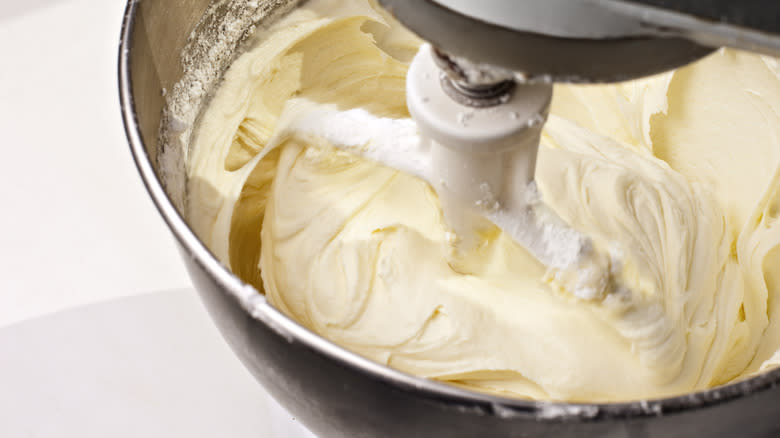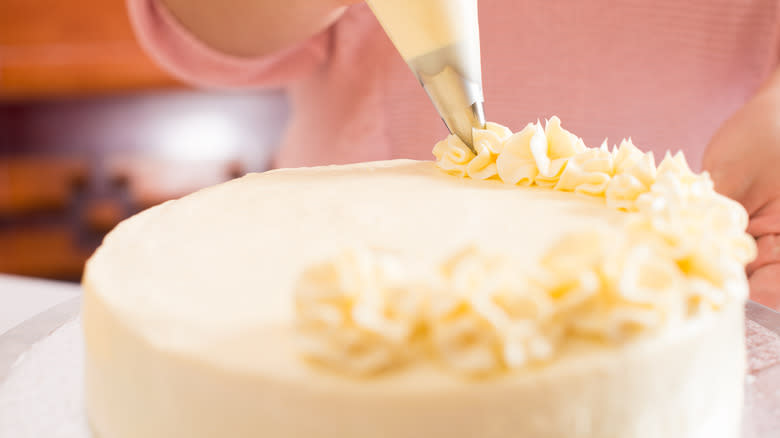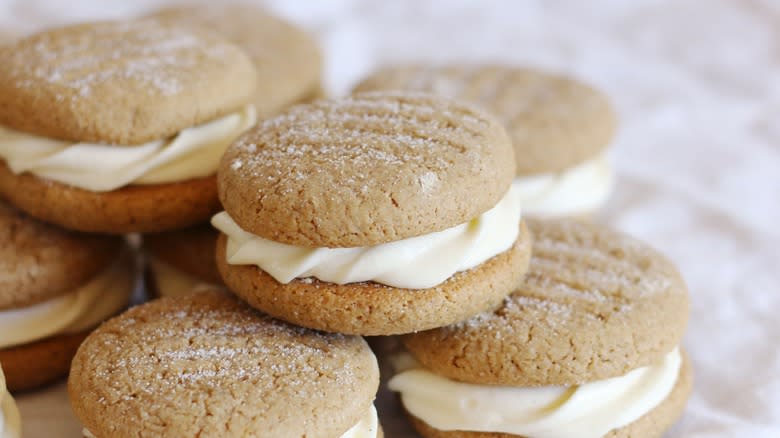The Tip For Preventing Bubbles In Your Buttercream Frosting

Cloudlike buttercream frosting is one of the most ethereal, dreamy toppings for your cakes, cookies, and beyond. It's also super approachable for the home baker, as a traditional American buttercream requires only five commonly found ingredients (milk or heavy whipping cream, confectioner's sugar, butter, salt, and vanilla extract) and a fairly straightforward process. But as simple as it may seem on paper to make this heavenly stuff, it can also be devilishly tricky at times.
One of the issues that can lead to a less than ideal frosting experience is an abundance of large bubbles, which makes it tough to get that perfect spread and pristine look. While it's important to whip enough air into your buttercream that it becomes light and fluffy, you don't want it to develop large air pockets, which will create a less-than-optimal texture.
The tip to avoiding this issue? Reach for your mixer's paddle attachment instead of the whisk. Known for volumizing, the whisk is designed to incorporate air. That's perfect for meringues or whipped cream but not ideal for silky buttercream. Using a whisk increases the odds you'll overwhip your frosting and wind up with those pesky air bubbles, while the paddle is engineered to cream together butter and sugar to velvety perfection — the signature consistency in a quality buttercream.
Read more: Cake Hacks Every Baker Will Wish They Knew Sooner
More Troubleshooting Tips For Better Buttercream Consistency

There are other overwhipping risks that go beyond attachment selection. It could simply be an oversight — for example, stepping away for a moment and forgetting to check your progress. It's important to be attentive to your task.
Another issue is you may be monitoring closely but aren't seeing desired results. Your instinct may be to continue whipping, when in fact you're over-aerating your frosting instead. This is why it's important to start with softened butter, which will whip faster than cold butter, thus reducing the amount of time required to achieve a creamy consistency — and the chances you might overwhip. This will also help prevent lumpiness, which can result from butter that's too cold and not whipped evenly. (This problem could also be caused by clumps in your powdered sugar, so before you begin, be sure to sift well, too.). Additionally, it's critical that you use powdered sugar rather than granulated sugar to avoid grittiness.
Adjusting the consistency for flavored buttercreams can also be a challenge. If you plan to get creative using extracts or alcohol (like bourbon or tequila), this could thin out your finished product. Keep some extra confectioner's sugar on hand and add a little at a time, stirring well until you've reached your preferred texture. This will vary slightly depending on your application and whether you need your frosting to be looser or a bit more firm, so be sure to test as you go.
How To Use Your Buttercream Frosting

Once you've gotten the process of making buttercream down, you open up a whole world of inspired applications and delightful treats. Classically, buttercream is a common cake frosting and a wonderful starting point as it's a fairly neutral flavor. Keep it simple by smearing it on a sheet pan vanilla cake for a crowd, spread on your favorite layered cake or cupcakes, or even mix it with cake crumbs to easily create whimsical cake pops.
You can also choose to lean into seasonal inspiration. Try eggnog buttercream around the holidays, red velvet buttercream for Valentine's Day, key lime buttercream for beach days in the summer, or Champagne buttercream to kick off a new year in sweet style. The sky's the limit for getting creative with your clouds of cream beyond cake pans. Use your favorite flavor of buttercream to create sandwich cookies, or as the filling in delicate macarons. You can even transform buttercream into a glaze for sables, sweet breads, or cinnamon buns by thinning it with milk. No matter how you opt to enjoy it, a velvety smooth buttercream without air bubbles is sure to bring smiles.
Read the original article on Daily Meal.

